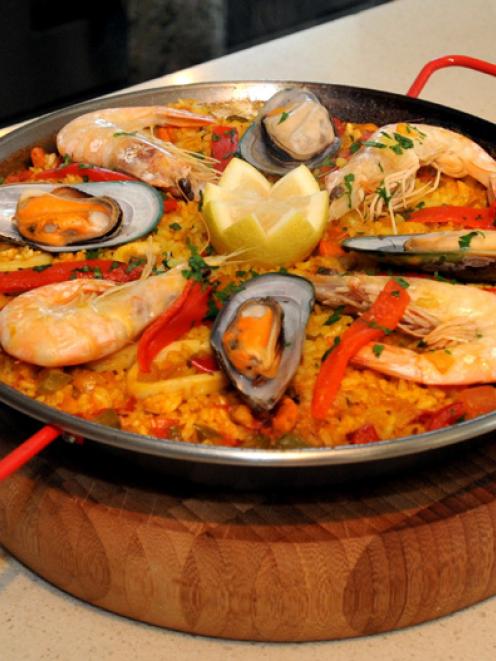Irene Fuertes, from Spain, shows how to make paella Valenciana.

Paella is a traditional rice dish that every Spanish family eats now and then, but on the coast it's a regular Sunday dish. In Spain the main meal of the day is eaten about 2pm and a light supper later in the evening.
It used to be a poor dish using leftover bits of bony meat, beans, fish and/or seafood, but it has evolved into a more luxurious dish using more expensive ingredients cooked by men, usually outdoors.
It can be made in large quantities and on Paella Day massive ones are cooked by several chefs in town squares. Traditionally, meat paella is eaten with wooden spoons and seafood paella with mussel shells, Ms Fuertes says.
Paella is also the name of the shallow, wide pan in which the dish is cooked and served - you can, of course, use an ordinary pan. Everybody has their own version of paella. This is based on Irene's grandfather's recipe but she has adapted it to New Zealand ingredients.
Paella Valenciana
Serves 4

1 onion, diced
1 red capsicum, seeded and diced
2 cloves garlic, sliced
3 tomatoes, diced
6 Tbsp olive oil
pinch of saffron
2 tsp pimenton dulce (Spanish paprika)
500g white fish, such as red cod
8 raw prawns, peeled and diced
1-2 squid tubes, cut into rings
2 cups medium-grained rice such as arborio
4 cups fish stock
salt and pepper to taste
250g clams
8 mussels in their shells
4 raw tiger prawns, unpeeled
To decorate
pimento del piquillo (Spanish roasted capsicum)
finely chopped parsley
lemon
Method
One of the tricks of cooking paella is to chop everything the same small size, she says.
Chop the onion, red capsicum and garlic. Dice the tomatoes and cut the fish, prawns, and squid into small pieces.
Put the stock on to heat.
Put the paella pan over a medium heat. It's important that the flame or element should be almost as big as the pan so it cooks evenly.
Heat the oil and when hot add the saffron, then the onion, garlic and capsicum. Stir until softened. Stir in the pimenton dulce, then add the tomatoes and stir. Season with pepper and a little salt, remembering the the stock is salty and will reduce.
Add the white fish, and when it is half-cooked, add the rest of the chopped fish reserving the shellfish in their shells and the scampi for decoration. Stir but don't overcook.
Add the rice then the hot stock. Once the rice and stock are in the pan, just stir briefly to even the mix, then leave it alone so the water can evaporate and a crust form on the bottom of the pan. Leave to simmer for 10 minutes.
Meanwhile, clean the mussels and remove any beards, discarding any that don't close.
After 10 minutes, turn the heat down and arrange the tiger prawns, mussels and clams if using, attractively on the top. Cover with a lid or tinfoil and leave to simmer for another 10 minutes until the scampi are cooked, the mussels opened, the stock absorbed and the rice is done. There should be a crisp crust on the bottom of the rice which many people say is the best bit.
Decorate with piquillo roasted peppers, and finely chopped parsley. Cover with a clean tea towel and leave to rest for five minutes. Paella should be loose and relatively dry, not sticky.
Serve hot in the cooking dish with lemon wedges if you like.
Tips
• In Spain they usually use monkfish or angler fish, but any white fish with a firm texture will do.
• If you can't get Spanish paprika, you can use regular paprika but the flavour is not the same.
• Valencia rice is used in Spain, but Irene uses arborio or risotto rice.
• In Spain they would make their own fish stock, but here you can buy it. The quality of the paella comes from the quality of the stock, Irene says. You could also use chicken stock, although the flavour will be different.
• Irene could not get clams so she used scallops instead and chopped them with the white fish.
• Saffron is traditionally used to colour and flavour the paella, but because it's expensive, a cheaper yellow colouring is sometimes used.
• Roasted pequillo peppers can be found in jars in good supermarkets.
• Thanks to Afife Harris and Centre City New World.
